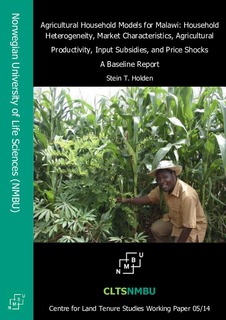Resource information
This report documents agricultural household models developed for agricultural policy analyses related to the assessment of impacts of agricultural input subsidies and maize technology choices in Malawi. The models have been calibrated to a typology of households in Central and Southern Regions of Malawi based on household survey data collected for the period 2005-2010. Households are assumed to be drudgery averse and rational given their preferences and the resource constraints and imperfect markets they face. The impacts of varying access to resources, input subsidies, off-farm employment opportunities, and prices during the period of study are simulated. The models in particular demonstrate the vulnerability of land-poor households and their dependence on non-farm income for them to meet their basic needs. Access to improved maize varieties and subsidies may facilitate land use intensification and survival on smaller farms. Price shocks in form of higher fertilizer prices and lower tobacco prices contribute to further impoverishment while the costs of the input subsidy program also reached nonsustainable levels during the period of study. The models give insights about some possible avenues for scaling down the subsidy program towards a more sustainable level. Reduction of subsidies from two bags to one bag of fertilizer per household and concentration of targeting towards more land-poor households can be two important mechanisms. Rather than providing free improved maize seeds it may be better to improve the availability of improved seeds in local markets.
NORAD ; CIMMYT

